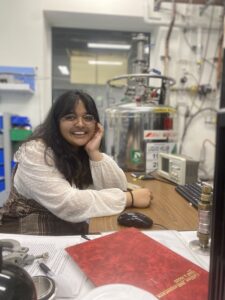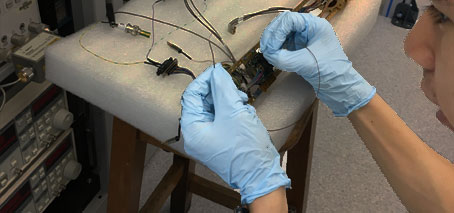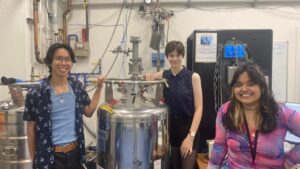A group of Sydney Quantum undergraduates have recently finished a summer term with Alex Hamilton’s QED group at UNSW, gaining practical experience with quantum devices as they worked alongside FLEET and QED researchers.
Over the course of their six-week placement, students pursued individual projects, developing skills in device fabrication and experimental process.
The UNSW Physics Quantum Electronic Devices group investigates electrical and optical properties of nanometre-scale semiconductor devices for future low-energy and quantum information applications.
Jacinta May: Investigating phenomena of the superconducting spin gap in 1D quantum point contacts.
Year of study: 3rd Year
Degree studying: B Science / B Advanced Studies, Double Major in Physics and Chemistry (at the University of Sydney)
“Nothing compares to the beauty of watching these devices cascade into quantum Hall plateaus. To have the opportunity of assisting with the fabrication and actual creation of these quantum point contacts, and to characterise its environment through measurement under cryogenic conditions, was to be privy to (as Feynman might put it): “one new corner of nature’s pattern of beauty and true majesty revealed.” Echoing Feynman’s sentiment, that was indeed my reward throughout this research experience.”
Krittika Krittika Kumar: To increase the length of 1D systems to allow us to better probe interesting spin physics
Year of study: 5th year
Degree studying: Physics and Computer Science
“Fabrication is fun, soul crushing and rewarding, all at the same time”

Following two summers working with QED as a summer student, Krittika Kumar will join the group
as an Honours student this year, fabricating and measuring long quantum point contacts.
Under the leadership of FLEET’s Deputy Director Prof Alex Hamilton, the QED lab is key in the Centre’s mission to develop topological transistors for a future generation of low-energy electronics.
The group examines the fundamental properties of low-dimensional systems in advanced semiconductor devices, and the development of new semiconductor and superconducting devices. Quantum semiconductor devices are fabricated at UNSW, and examined using a variety of electronic and optical probes, at milliKelvin temperatures and in strong magnetic fields.


